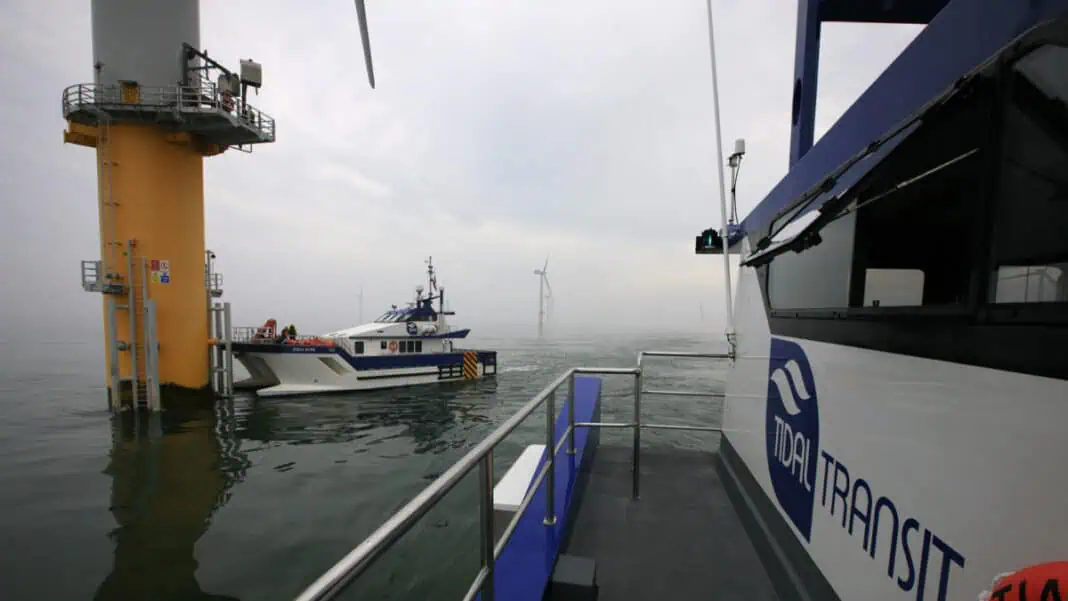In this article, Leo Hambro, commercial director at Tidal Transit, explores how emerging technologies are not only fuelling industry expansion but also playing a vital role in driving decarbonisation efforts, and highlights the importance of research and development (R&D) innovation in meeting new challenges and shaping the future of the maritime sector.
Driven by the rapid growth of offshore wind energy, the maritime sector is set for significant expansion but must navigate a complex and evolving landscape that calls for innovative and sustainable approaches. Offshore wind farms depend on advanced maritime infrastructure for installation, operation and maintenance – processes that have traditionally been carbon intensive. However, through a focus on electrification, energy efficiency, alternative fuels and resource circularity, robust R&D efforts can help steer the sector towards the critical transition to a low-carbon economy.
And the money for developing green solutions is certainly there. Through the latest Clean Maritime Demonstration Competition – CMDC4 – the Department for Transport (DfT) awarded £33 million in grants to develop green technologies for ports and ships, bringing total CMDC funding £128 million. These grants are designed to stimulate R&D efforts in finding and adopting sustainable practices and technologies, and to pave the way towards a greener maritime industry. Further green innovation initiatives, such as those run by Innovate UK, continue to encourage collaboration between industry, academia and government, and foster a culture of technological evolution.
R&D needs a strategic focus
While diverting capital into R&D is a necessity, it is important that these resources are channelled effectively, so a strategic and often lateral approach is required to effectively identify and prioritise the most pressing research areas. For instance, developing cost-effective and scalable battery technologies alongside supporting charging infrastructure has demonstrated that the combined impact can be greater than the sum of its parts, leading to substantial long-term carbon reductions. In many cases, electrification outperforms alternative fuels such as hydrogen and hydrotreated vegetable oils in terms of raw energy efficiency. Therefore it’s crucial to, tackle challenges holistically using a systems-wide approach to find the best solutions.
Another key area of focus for maritime should be resource circularity. The industry is facing pressure to reduce its carbon footprint, but this can be addressed through more than just reducing reliance on fossil fuels. Manufacturing, maintenance and wider supply chains can also be decarbonised by adopting a circular economy approach. For example, retrofitting older vessels to utilise battery powered propulsion systems offers a closed-loop, practical solution which keeps parts and materials in the value chain for far longer and greatly extends the lifespan of vessels. Adapting existing ships and infrastructure to accommodate modern technologies can not only lead to substantial environmental benefits and increased resource efficiency, but result in long-term cost savings.
Offshore Renewable Energy (ORE) Catapult is the UK’s leading technology innovation and research centre for offshore renewable energy. David Cooper, Partnership Manager: Clean Maritime, shared with us his thoughts on the need for strategic focus. He says that maritime decarbonisation is a technologically achievable goal, but to achieve truly zero-emissions operations, and an affordable price, we have to embrace innovation and think beyond just ‘drop-in’ replacement fuels. According to Cooper, the offshore wind maritime sector provides an exciting opportunity whereby the vessels themselves are travelling out to the very power plants that could be providing the zero-emission fuels of the future.
A case in point: at Tidal Transit, we are spearheading a design and engineering project to retrofit a diesel-powered crew transfer vessel (CTV) to run on 100% battery power. The vessel, being re-named e-Ginny, is being fitted with more than three megawatt-hours (MWh) of battery capacity, electric motors and propulsion pods. This end-result will not only be an emissions-free CTV, but the process will also mitigate the traditionally wasteful and carbon heavy process of decommissioning an older vessel. At the same time, the project is also expanding supportive charging infrastructure by installing both an onshore charging system and an offshore wind turbine-based charger. These critical solutions will enable direct electric-CTV charging on location, greatly increasing the time and range that electric vessels can stay in operation and helping accelerate electrification across the industry.
Another crucial factor to consider when planning R&D strategies is health and safety. As new technologies and fuels are introduced, ensuring that safety procedures keep pace with evolving technologies is paramount. This may involve developing stringent safety standards on the handling and transport of hydrogen or implementing practices that enable safe battery maintenance and operation at sea. When advancing new technologies, safety measures should be developed concurrently and seamlessly integrated into existing health and safety frameworks to ensure comprehensive protection.
Unlocking the green economy with R&D
The growing maritime industry presents exciting opportunities but also faces significant challenges. Strategic R&D is essential for driving innovation and ensuring that technology keeps pace with industry growth, investor trends and regulatory requirements. By adopting a holistic approach and directing R&D efforts towards key areas such as electrification and low-carbon technologies, the maritime sector can chart a course to a more robust and resilient future.
A strategic approach will not only support industry expansion but also ensure that growth aligns with broader environmental goals, paving the way for a more circular and sustainable maritime sector.












